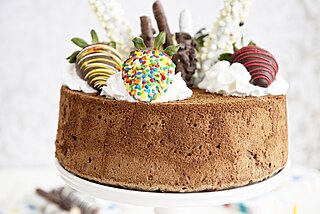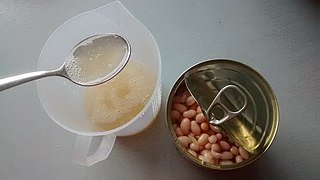An emulsion is a mixture of two or more liquids that are normally immiscible owing to liquid-liquid phase separation. Emulsions are part of a more general class of two-phase systems of matter called colloids. Although the terms colloid and emulsion are sometimes used interchangeably, emulsion should be used when both phases, dispersed and continuous, are liquids. In an emulsion, one liquid is dispersed in the other. Examples of emulsions include vinaigrettes, homogenized milk, liquid biomolecular condensates, and some cutting fluids for metal working.

A mousse is a soft prepared food that incorporates air bubbles to give it a light and airy texture. Depending on preparation techniques, it can range from light and fluffy to creamy and thick. A mousse may be sweet or savoury.

Marshmallow is a confectionery made from sugar, water and gelatin whipped to a solid-but-soft consistency. It is used as a filling in baking or molded into shapes and coated with corn starch. This sugar confection is inspired by a medicinal confection made from Althaea officinalis, the marsh-mallow plant.

Surfactants are chemical compounds that decrease the surface tension or interfacial tension between two liquids, a liquid and a gas, or a liquid and a solid. The word "surfactant" is a blend of surface-active agent, coined c. 1950. As they consist of a water-repellent and a water-attracting part, they enable water and oil to mix; they can form foam and facilitate the detachment of dirt.

Meringue is a type of dessert or candy, of French origin, traditionally made from whipped egg whites and sugar, and occasionally an acidic ingredient such as lemon, vinegar, or cream of tartar. A binding agent such as salt, flour or gelatin may also be added to the eggs. The key to the formation of a good meringue is the formation of stiff peaks by denaturing the protein ovalbumin via mechanical shear.

Angel food cake, or angel cake, is a type of sponge cake made with egg whites, flour, and sugar. A whipping agent, such as cream of tartar, is commonly added. It differs from other cakes because it uses no butter. Its aerated texture comes from whipped egg white. Angel food cake originated in the United States and first became popular in the late 19th century. It gained its unique reputation along with its name due to its light and fluffy texture and white color.

Foams are materials formed by trapping pockets of gas in a liquid or solid.

Egg white is the clear liquid contained within an egg. In chickens, it is formed from the layers of secretions of the anterior section of the hen's oviduct during the passage of the egg. It forms around fertilized or unfertilized egg yolks. The primary natural purpose of egg white is to protect the yolk and provide additional nutrition for the growth of the embryo . Egg white consists primarily of about 90% water into which about 10% proteins are dissolved. Unlike the yolk, which is high in lipids (fats), egg white contains almost no fat, and carbohydrate content is less than 1%. Egg whites contain about 56% of the protein in the egg. Egg white has many uses in food as well as many other uses.

Froth flotation is a process for selectively separating hydrophobic materials from hydrophilic. This is used in mineral processing, paper recycling and waste-water treatment industries. Historically this was first used in the mining industry, where it was one of the great enabling technologies of the 20th century. It has been described as "the single most important operation used for the recovery and upgrading of sulfide ores". The development of froth flotation has improved the recovery of valuable minerals, such as copper- and lead-bearing minerals. Along with mechanized mining, it has allowed the economic recovery of valuable metals from much lower-grade ore than previously.

A bubble bath is a filled bathtub with a layer of soap bubbles on the surface of the water. Less commonly, aerated or carbonated baths are called bubble baths.

Indigenous ice cream, also known as sxusem, is a Canadian whipped confection made from soapberries and other various fruits; it has been eaten as a traditional dessert by many First Nations peoples. It has been suggested that it was first produced in the Interior Salish territory of British Columbia which was located in the upper basins of the Columbia and Fraser rivers, and included tribes such as the Columbia, Lillooet, and Shuswap among others.

Microfoam is finely textured milk used for making espresso-based coffee drinks, particularly those with latte art. It is typically made with the steam wand of an espresso machine, which pumps steam into a pitcher of milk.

Whipped cream is heavy, double, or other high-fat dairy cream that is whipped by a whisk or mixer until it is light and fluffy and holds its shape. Cream aerated by the expansion of dissolved gas, forming a firm colloid, is also called whipped cream. It is often sweetened, typically with white sugar, and sometimes flavored with vanilla. Whipped cream is also called Chantilly cream or crème Chantilly.
A blowing agent is a substance which is capable of producing a cellular structure via a foaming process in a variety of materials that undergo hardening or phase transition, such as polymers, plastics, and metals. They are typically applied when the blown material is in a liquid stage. The cellular structure in a matrix reduces density, increasing thermal and acoustic insulation, while increasing relative stiffness of the original polymer.
Foam fractionation is a chemical process in which hydrophobic molecules are preferentially separated from a liquid solution using rising columns of foam. It is commonly used, albeit on a small scale, for the removal of organic waste from aquariums; these units are known as "protein skimmers". However it has much broader application in the chemical process industry and can be used for the removal of surface active contaminants from waste water streams in addition to the enrichment of bio-products.
Milk protein concentrate (MPC) is any type of concentrated milk product that contains 40–90% milk protein. The United States officially defines MPC as "any complete milk protein concentrate that is 40 percent or more protein by weight." In addition to ultrafiltered milk products, the MPC classification includes concentrates made through other processes, such as blending nonfat dry milk with highly concentrated proteins, such as casein.
Continuous foam separation is a chemical process closely related to foam fractionation in which foam is used to separate components of a solution when they differ in surface activity. In any solution, surface active components tend to adsorb to gas-liquid interfaces while surface inactive components stay within the bulk solution. When a solution is foamed, the most surface active components collect in the foam and the foam can be easily extracted. This process is commonly used in large-scale projects such as water waste treatment due to a continuous gas flow in the solution.

Aquafaba is the viscous water in which legume seeds such as chickpeas have been cooked. Its use in cuisine was the discovery of the French musician Joël Roessel.

A milk frother is a utensil for making milk froth, typically to be added to coffee. It aerates the milk, creating a thick but light foam. Milk frothers were introduced through the use of espresso machines that contained steamed wands that would froth steamed milk. Although created in Italy, the espresso machine and steam wands were exported internationally to other countries, and frothed milk was introduced around the world.
Interfacial rheology is a branch of rheology that studies the flow of matter at the interface between a gas and a liquid or at the interface between two immiscible liquids. The measurement is done while having surfactants, nanoparticles or other surface active compounds present at the interface. Unlike in bulk rheology, the deformation of the bulk phase is not of interest in interfacial rheology and its effect is aimed to be minimized. Instead, the flow of the surface active compounds is of interest..















